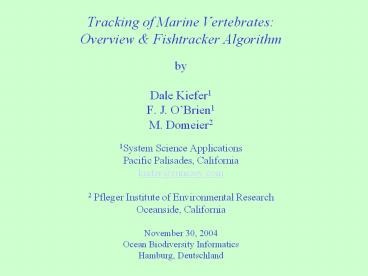Tracking of Marine Vertebrates: Overview PowerPoint PPT Presentation
1 / 20
Title: Tracking of Marine Vertebrates: Overview
1
Tracking of Marine VertebratesOverview
Fishtracker AlgorithmbyDale Kiefer1F. J.
OBrien1M. Domeier21System Science
ApplicationsPacific Palisades,
Californiakiefer_at_runeasy.com2 Pfleger
Institute of Environmental ResearchOceanside,
CaliforniaNovember 30, 2004Ocean Biodiversity
InformaticsHamburg, Deutschland
2
Statement of the Challenge
Effective conservation of most marine vertebrate
populations requires an assessment the life
history of the species. Electronic tags offer
the promise of filling some of the missing gaps.
The community of scientists and resource managers
using such tags have great need of an information
system that fully integrates data they have
acquired from tagged marine organisms with
environmental information such as satellite
imagery and data streams from weather buoys and
drifters.
3
Mirounga leonina Antarctic Elephant Seal
elephant seal
4
(No Transcript)
5
Laysan albatross tracking and GIS
6
(No Transcript)
7
Great White Shark
8
EASY software architecture
- 4 dimensional system for marine applications WGS
84/geodetic representation - interfaces for models, spreadsheets, databases,
and Internet - PC Desktop Web-enabled GIS applications
9
(No Transcript)
10
(No Transcript)
11
Technical Challenge of Tracking Archival
Tagsspatial/temporal matching of sst from tag
and satellite image
Satellite SST sensor
sun
Imagery time series time i, temperature
(latitude j, longitude k)
clouds
Tag time series time i, temperature i, depth
i, irradiance i
12
(No Transcript)
13
Figure 3. Step 5 Costing the arcs a function of
temperature match for candidate pixels and
distance between consecutive pairs of candidate
pixels
Enumerate all possible arcs
Start
End
Estimate liklihood/cost for each arc
14
Fig 4. Step 6 calculating the best path by
summing the cost of cost of arcs for all possible
paths
Sum arc costs for all paths
Select lowest cost path(s)
Start
End
15
Fig 1. Fish Tag Options Window
- Unique features of the Fishtracker (OBrien)
Algorithm - includes a consideration of maximum swimming
speed of the fish - costs the distance to swim around land obstacles
- calculates the most likely path as a global
feature of the time series (analyzes thousands of
possible paths) rather than a serial solution
that is prone to much greater error
16
Fig.5. A typical display showing, simulation
control, path, superimposed on satellite imagery,
time series from tag
17
FishTracker SST-based latitude solutions vs.
Wildlife Computers and Microwave Telemetry
light-based latitude estimate False color
contours illustrating relative importance of the
range juvenile bluefin tuna occupy in the eastern
Pacific each color represents a relative
importance increase of 20. The polygon encloses
100 of position estimates for fish 159, 233, and
441 combined.
18
(No Transcript)
19
False color contours of seasonal spatial use and
movement pattern for fish 159 and 233 combined.
The smaller total range of fish 441 is
illustrated by polygon.
20
Demonstration

